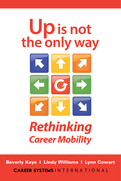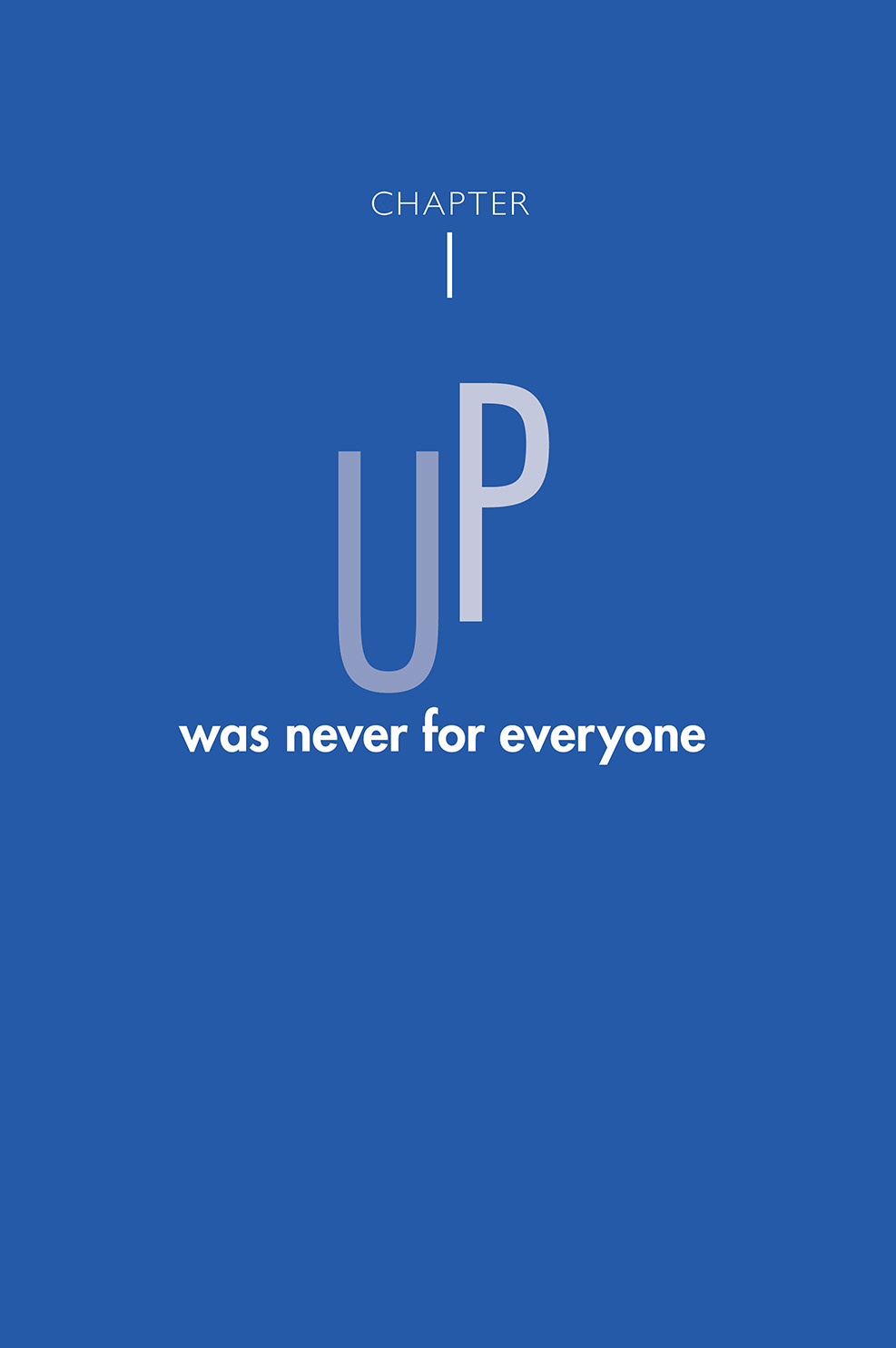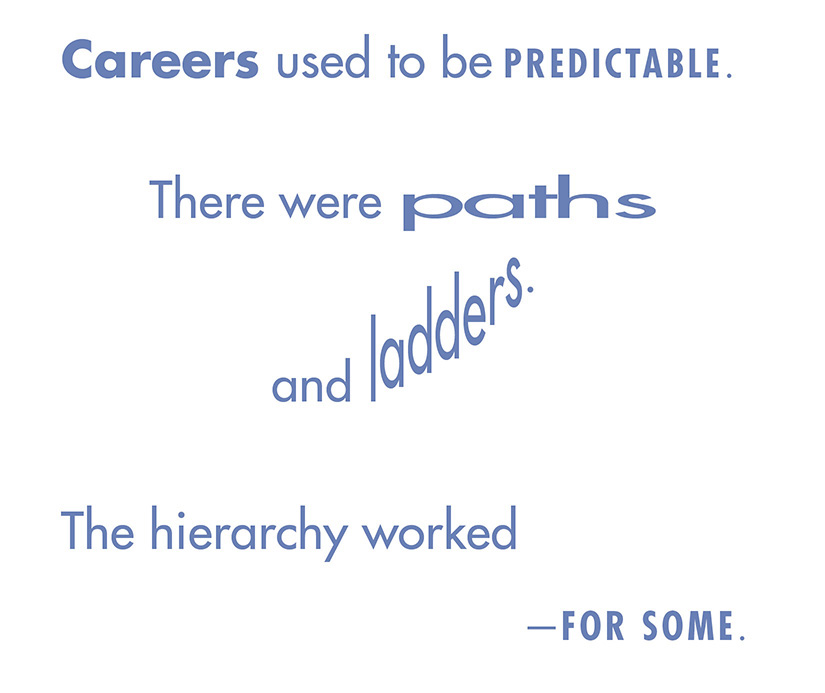
Download PDF Excerpt
Rights Information
Up Is Not the Only Way
Rethinking Career Mobility
Beverly Kaye (Author) | Lindy Williams (Author) | Lynn Cowart (Author)
Publication date: 09/12/2017
Move up or move out. When those two options appear to be the only ones, dissatisfaction grows and engagement suffers. In decades of studying careers around the globe, Beverly Kaye, Lindy Williams, and Lynn Cowart have found that, in fact, there are more options. And rethinking career mobility can lead you to them!
The authors show how managers, coaches, and employees can partner to determine what's best and what's next. Keep the same job but discover new ways to learn and grow? Explore moving to a position that could be a better fit? Step back without getting derailed? This book encourages readers to take a “kaleidoscope” view—to be open to ever-shifting patterns of opportunities and possibilities—so they can create a unique, personalized path to a truly rewarding career.
Find out more about our Bulk Buyer Program
- 10-49: 20% discount
- 50-99: 35% discount
- 100-999: 38% discount
- 1000-1999: 40% discount
- 2000+ Contact Leslie Davis ( [email protected] )
Move up or move out. When those two options appear to be the only ones, dissatisfaction grows and engagement suffers. In decades of studying careers around the globe, Beverly Kaye, Lindy Williams, and Lynn Cowart have found that, in fact, there are more options. And rethinking career mobility can lead you to them!
The authors show how managers, coaches, and employees can partner to determine what's best and what's next. Keep the same job but discover new ways to learn and grow? Explore moving to a position that could be a better fit? Step back without getting derailed? This book encourages readers to take a “kaleidoscope” view—to be open to ever-shifting patterns of opportunities and possibilities—so they can create a unique, personalized path to a truly rewarding career.
—Marcia J. Avedon, PhD, Senior Vice President, Human Resources, Communications and Corporate Affairs, Ingersoll Rand, plc
“Up Is Not the Only Way is so timely in today's ever-changing business world. This book provides a great mind map for how all people should be thinking about their careers, their ambitions, and what success really can look like for today and thirty years from now. I just wish I had it when I was just starting out!”
—Rob Lauber, Senior Vice President and Chief Learning Officer, McDonald's Corporation
“A thoughtful and practical guide for HR executives, managers, and employees, who all want to make career mobility conversations happen.”
—Peter Capelli, George W. Taylor Professor of Management and Director, Center for Human Resources, The Wharton School
“A bright gem of a book that's perfect for this new era of work, where mobility is critical to meaning and mastery at work. Whether you're just starting out or making a midcareer transition, it's a great way to reassess the path you are on.”
—Jim Kouzes, coauthor of the bestselling The Leadership Challenge and Dean's Executive Fellow of Leadership, Leavey School of Business, Santa Clara University
“This book is a refreshing take on a topic of interest to nearly everyone. Like a multifaceted diamond, it gives light in many directions. I heartily recommend this book to all.”
—Jack Zenger, CEO, Zenger Folkman, and bestselling coauthor of The Extraordinary Leader and Speed
“One responsibility of all leaders is to grow the talent on their team. This book suggests an array of mobility conversations and will help any leader feel more comfortable with that conversation.”
—Rosabeth Moss Kanter, Professor, Harvard Business School, and Chair and Director, Harvard University Advanced Leadership Initiative
“A great talent strategy focuses most on finding and growing the best talent in an organization. Bev Kaye and team provide practical, trusted insights for building strength from within.”
—Marc Effron, President, The Talent Strategy Group
“This is the first book that addresses the changed career environment of the 21st century and provides concrete career management steps you can take. Regardless of your tenure or organizational level, it will give you effective control of your career and newfound success.”
—China Gorman, Advisor, Speaker, and Board Member, Universum, Motivis Learning, and PeopleStrong
“Helping people grow should be in the job description of every leader at every level. This book makes it easier for both managers and direct reports to talk about career development. Up Is Not the Only Way is a must-read!”
—Ken Blanchard, coauthor of The New One Minute Manager® and One Minute Mentoring
“Filled with one ‘aha!' moment after another, Up Is Not the Only Way inspires and educates. It teaches us that career success is not one-size-fits-all—and that's a good thing. You'll never think of your career in the same way again.”
—Marshall Goldsmith, international bestselling author or editor of thirty-five books, including What Got You Here Won't Get You There and Triggers
“The authors have written the only book I know of its kind, addressing a critically important career topic. Is there any other book like this?”
—Verne Harnish, author of Scaling Up and CEO, Gazelles
“A lively, compelling read that voices the work/life considerations that are on the minds of many mid- to senior-level professionals and their managers. It hits the mark with powerful examples of career mobility options that can drive tremendous personal as well as professional satisfaction.”
—Ed Tetrault, Senior Vice President and Chief Human Resources Officer, Apex Tool Group
“A must-read for everyone in today's workforce as it provides valuable insights and practical approaches for meaningful career discussions.”
—Tamar Elkeles, PhD, Chief Talent Executive, Atlantic Bridge Capital, LLC
“With the high demand and limited supply of available talent in our industry and more of our employee base being made up of millennials, we needed an approach to developing talent that would enable us to attract and more importantly retain our people. We have leveraged the concepts from this book to create a strategic talent development approach for our organization that works!”
—Joel Tobin, Vice President, Talent Acquisition and Development, Catalent Pharma Solutions
“This book will open your eyes to the landscape of possibilities beyond what lies ahead—for yourself, your employees, your family, your friends, and your organization.”
—Sue Padernacht, Chief Learning Officer and Vice President, Talent and Organization Development, Tribune Online Content
“No talent strategy can be complete without the proper attention on how employees can grow within their current organizations. Written in a practical manner, this book offers great ideas for preparing for those development conversations.”
—Jayne Johnson, Vice President, Global Organization and Leadership Development, Vertex Pharmaceuticals
“This is one of those rare books that speaks to both the employee and the manager, recognizing that a career conversation is a two-way dialogue. Both need to know how to have effective and robust conversations that take into account the realities of career mobility today—as ‘up' is not the only way anymore!”
—Meribeth Germino, MALD, Principal Executive Development Consultant, Learning and Organization Development, Genentech
“The traditional career ladder, where people advance rung by rung, is gone. Today, lateral moves, stretch assignments, and career resets are all part of the lifelong journey toward professional success and personal fulfillment. This book is an invaluable tool in helping people navigate this complex new landscape.”
—Sekhar Ramaswamy, Chief Talent Officer, Prudential
“Everybody deserves career bliss! This book is the GPS, the compass that everybody should follow no matter where you are in your career. Your employees will thank you. You will thank yourself.”
—Jamie Graceffa, Director of Organizational Development, Philips, and author of Career Control
“In my experience, I've found that individuals join organizations that they believe will grow their careers. This book will help managers and employees at any level prepare for the development conversation and understand what it takes to own your own learning.”
—Kimo Kippen, Vice President, Global Workforce Initiatives, Hilton
“As organizations become flatter and new technologies push businesses to transform, the most sought-after and successful employees have a variety of experiences that allow them to connect dots across silos, build relationships across departments, and prove they are agile—succeeding in lots of different assignments and challenges. Traditional career paths don't often give you these experiences. This book helps readers understand the many ways they can grow their careers, how to evaluate their options, and what steps to take to achieve their goals.”
—Lauren Starkand, Senior Vice President, Talent and Diversity, Global Consumer Banking, Citi
“To successfully navigate this new era of career growth and talent development, we all need fresh thinking as well as time-tested tools. This book accomplishes both objectives, providing those contemplating ‘what's next?' and ‘what's best for me?' with a contemporary game plan firmly grounded in the wisdom of experience. I highly recommend it for all.”
—Kevin D. Wilde, Executive Leadership Fellow, Carlson School of Management, University of Minnesota, and former Chief Learning Officer, General Mills
“Up Is Not the Only Way provides an elegant and simple approach to the complex challenge of career in today's organizations. By enlisting individuals, their leaders, and organizations in a mindful ‘think about, talk about' approach, the authors inspire positive accountability for managing careers in an uncertain world.”
—Tim Richmond, Senior Vice President, Human Resources, AbbVie
“Up Is Not the Only Way is a classic ‘teach them to fish' tool for thinking broadly about professional growth and building personally fulfilling, custom careers.”
—Fran Lawler, Vice President of Human Resources, Engineered Fastening, Stanley Black & Decker
“Knowing yourself is the key to personal success (however you define it), and this book has many practical ways to accomplish that.”
—Amy Meeuwenberg, Lead Performance and Engagement Specialist, Enterprise Talent Development, Amway

As downsizing, restructuring, and delayering took hold in the late 1980s, old ladders became largely inaccessible. Some rungs disappeared, and the space between others shifted from steps to leaps. At the same time, individual aspirations and company needs were evolving. Terms like work–life balance were overheard in break rooms. Organizations began to examine how breadth of experience weighed against depth of expertise during talent reviews. The world of work was changing.
Careers today happen in that world—a world that continues to change. The environment is more global, more multigenerational, more dispersed, diverse, and complex than ever before. Hierarchies continue to flatten. Organizational structures are flexing. Even the value people place on work is changing.
Employees play multiple roles—from individual contributor to peer to leader and back, sometimes in the same day or within the same assignment. Roles emerge and evolve based on tasks and needs. Carefully written descriptions no longer define the boundaries of a job. Teams form and disperse based on projects. Feedback comes from multiple sources. The ladder, if it’s still there, may be harder to see and tougher to climb.
Is This the End of the Career as We Know It?
Every industry is changing. As a result, internal workplace structures are changing as well. Up—the promotion path and perhaps even a ladder or two—may still exist, and could still be a goal—for some. However, as levels of the hierarchy have disappeared, promotional opportunities have become less available, so the route to a promotion may take new turns. Someone who wants to manage others can still get there and, with the right mix of experiences, will likely arrive better prepared to take on the role.
Flattened organizations and limited career ladders don’t spell the end of growth or careers. Opportunities are there—different and varied, but very much still there, and even more plentiful. The next change frontier, then, is people’s mind-sets, and that means changing the conversation, especially about careers.
Let’s Be Honest
Up was never for everyone. It still isn’t. Managing someone else is not on everyone’s radar. Neither is taking on increasing levels of responsibility (really!). Not everyone wants to move up. That doesn’t mean a rewarding career is out of reach.

The message has been out there for a while now that individuals own their careers. What does that really mean? We think it means that the definition of career success is up to each one of us. Every time circumstances shuffle the deck, you can deal yourself a new hand. That’s good news . . . actually that’s great news! We are the only ones who can envision and imagine what success will look like. And, to add to that great news, as the creators of our career success pictures, we are free to alter them when and how we choose to! That is what it means to own a career.
But, if we own it and we can create it, how do we do it?
First it’s about being mobile.
Career Mobility . . .
. . . is essential for individuals at all levels. Each one of us needs to exercise agility and resilience that stable workplaces did not require. No longer is mobility just about physically moving to another building or town. It’s more than getting promoted. It’s sometimes just being willing to continue to learn and grow and stretch.
. . . is about flexibility and agility. Like the navigation systems we rely on to reroute our travels based on traffic patterns, career mobility means flexing, adapting, and anticipating what’s next.
. . . involves a rich mix of experiences, roles, assignments, and options. Careers today require us to be open to exploring multiple opportunities and possibilities. Great careers will be the payoff for employees who watch for and recognize emerging growth opportunities and are ready with alternatives when options fade or change.
Second, it’s about ownershift!
Ownershift: Who Does What?
We’ve all heard that employees own their careers. The organization needs to provide tools and resources, and managers need to support employees’ career development. It’s a partnership. Nothing new there!
What is new is talking less about the ownership and more about the ownershift—the need to fine-tune who owns what—and about what each player needs to do to demonstrate commitment to the partnership.
Individuals must define what success means to them personally. This means testing assumptions and exploring options. It means learning and applying the insights gained from exploration. It means building plans and following through on them. It requires being a little introspective and taking time to figure things out—like what skills they have or need, what interests them, and what they value most about their work. It means asking for feedback and listening, even when it’s not all good news. And, most importantly, it means being willing to take responsibility for your future. Careers belong to individuals. A career evolves within a network of partners and support, but, bottom line, it’s up to the owner to shape it and live it.

Managers, coaches, and mentors provide support through conversations; sharing stories; listening to individuals describe their interests, skills, and values; reacting to plans; offering feedback and connections. That support is vital to ownershift! When managers offer on-the-job learning, let’s call it what it is—development. Stretch assignments are growing-in-place opportunities, not just “extra work.” When someone completes a stretch assignment, taking the time to debrief it will make learning stick. What did you learn? What skill did you acquire or sharpen? How will you apply what you learned? The support role includes preparing individuals to learn, helping them focus on what they learned, and then guiding them to apply the new skill or capability. It’s a big role, sure. And it might mean shifting what you presently think it involves, but that’s what we mean by ownershift. Each partner needs to understand the expectations and deliver on them.
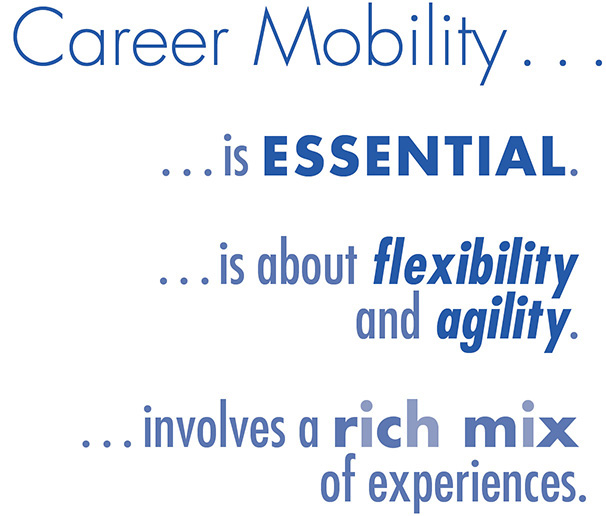
Organizations have a role to play as well. The systems, processes, and tools the organization provides deliver on promises of a development culture. However, the organization’s role doesn’t end there. Through senior leadership, human resources, and related groups, the organization must ensure that employees have access to the tools—that employees know where to find them, what they offer, and how to use them. The organization must thread the message of development through existing communications vehicles and devise new ways to promote growth in all its shapes, sizes, and forms. Some employees tell us that their companies still celebrate only promotions—people who are moving up. Ownershift requires a change in that mind-set. This book can help accomplish that shift.
When the Shift Hits the Fan
We know that not everything happens as smoothly as we might like. Every organization has its own culture and unique environment. So what do you do if
. . . ownershift is just words without action?
. . . individuals are not ready?
. . . the organization isn’t fully on board?
. . . some managers are just not good at this development thing?
Do you simply sit back and wait for the others to catch up? Certainly not! Whether development and growth are tracked and measured or left to chance, they are fundamental to building the future—for individuals and for organizations! Don’t wait! Start now. You can start small, with a few conversations. When career conversations are happening, when individuals begin to talk about ideas and aspirations, when feedback is candid and insights emerge, everyone involved will know—you will know—you have completed your ownershift!
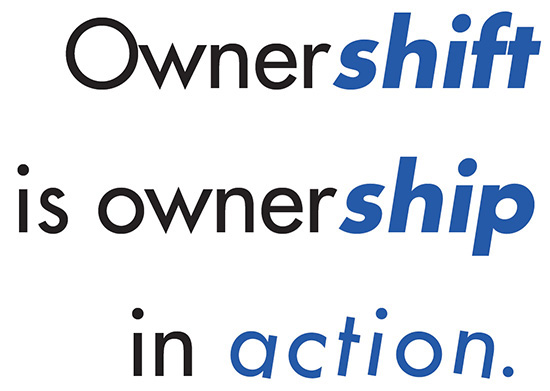
At the end of each chapter we will share some questions to use as conversation starters. The questions will help you explore and build deeper dialogue about careers—yours and others’! The questions and topics will challenge you to think more broadly, whether in preparation for a conversation with your peers, with your own manager or coach, or perhaps with the leaders of your organization.
For this first chapter, here are some things for you to ponder:
* What does career success mean to you?
* How do you feel about up not being the only way?
* Considering the information in this chapter, how mobility- minded are you? What gets in your way?
* How prepared are you for an “ownershift”?
* What does growth look like for you right now?







